Lion Bikes
Lithium Ion propelled personal transportation
Monday, July 19, 2010
Monday, July 12, 2010
Piper Down
The joy was short lived unfortunately.
I went out for a quick blast on Sunday afternoon and about 2km out after riding down a dirt path in a park the throttle stopped responding. The red LED light was still on the controller and the Cycle Analyst had juice as well but nothing happened when I opened the throttle.
I suspect some connection in the throttle assembly got damaged from a bump on the trail but since I'm no electronics wizard this could take me a while to figure out. Fortunately at least I have a multi-meter from an old PC repair kit I had lying around and I have been in touch with the folks at Grin so maybe it will turn out to be something simple.
In the mean time I'm grounded.
Time to bone up on basic electric circuits and troubleshooting.
The Maiden Voyage
The first 'flight' was a resounding success.
Approximately 11km loop to meet the family at the water park and a beer run. Moderate uphill climbs which the bandit handled very well.
The best way to describe the feeling is like being bionic. Riding up hills is a real treat with the additional boost of the 48 volts.
- Total elevation change was a few hundred feet.
- Unknown speed due to the fact the speedometer isn't set up yet
- Reported Ah usage was 2.97 which projects a range of around 30km.
I even had to do a little off-road detour in the park and carry the bike across a creek crossing. It was heavy but do-able.
Sunday, July 11, 2010
Project Bandit: the build
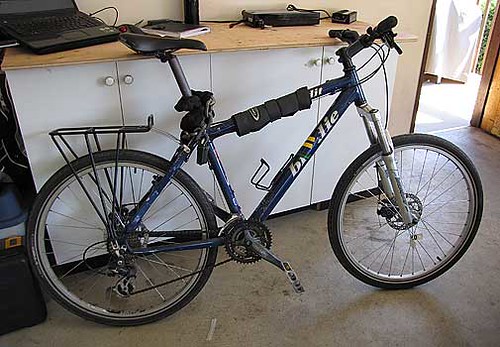
The big day has finally arrived. It's time to convert my old Brodie hard tail to an electric bike. It's like Christmas and a birthday rolled into one!
This post documents the steps I took to complete the conversion using the kit described in
It was very straightforward with no need for any exotic or special tools.
you need at least:
- Allen key wrenches
- Phillips screwdrivers
- a couple of large adjustable wrenches / vice grips
it would be nice to have:
- bike stand so you can access the whole bike by walking around it. Leaning against a bench gets tiring.
- cordless drill
- caliper
The Steps:
1) Remove existing rear wheel
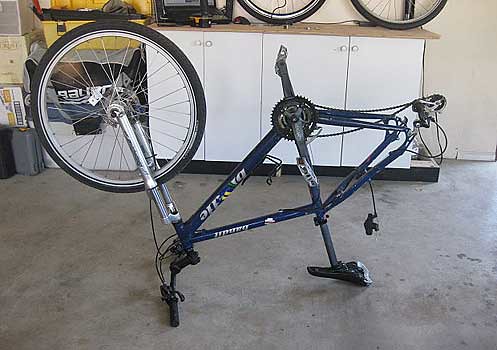
2) Mount disk brake on new wheel (if your bike has disk brakes.)
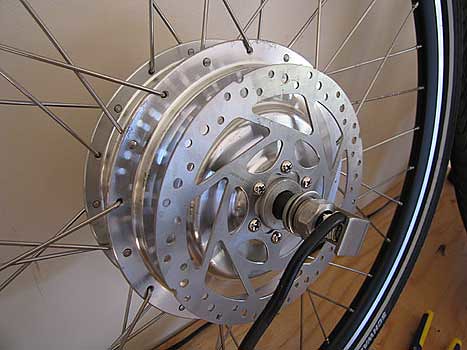
3) Mount the gear cassette. Make sure to count the number of gears on your existing set up and match it. I think I missed a spacer as the gears are making some noise on the highest and lowest. I will be looking into this but I doubt it is serious (note to self: get a book on bike mechanics)
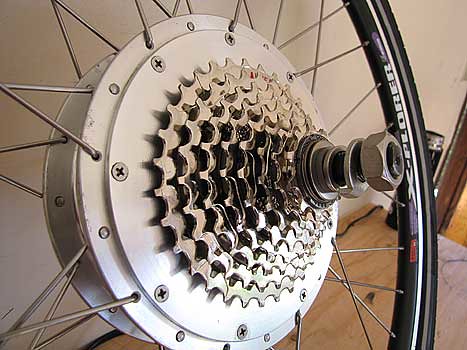
4) Loosen torque nut to expose axle flats for dropout. The wheel comes with the nut tightened up to the 14mm main axle obscuring the axle flats for the dropout. As a noob I didn't realize this until a friendly exchange on the Endless Sphere forum set me straight.
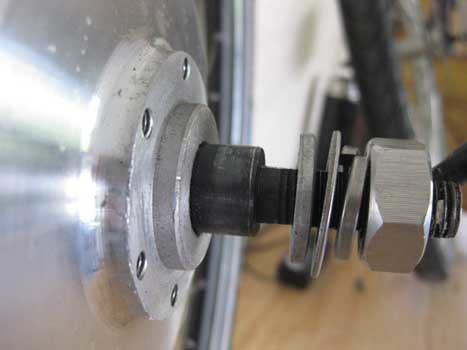
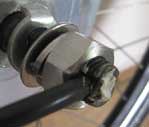
I have some concerns around where the wire comes out of the axle. It has some kind of what looks like silicone sealant but doesn't look to be fully sealed. Before taking the bandit out in the rain I will be looking to provide a better seal on this interface.
5) Install new wheel (looks pretty sharp)
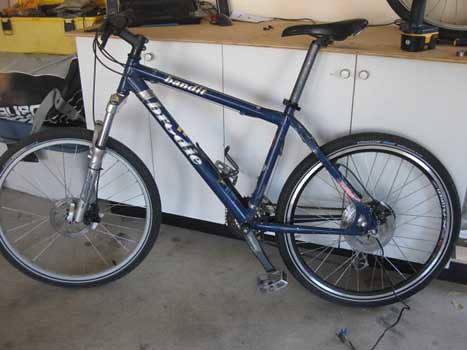
Another observation from the hub/axle installation is that the wires actually come out the back side of the bike. It seems to me it would be better if the wires came out the front side as it would reduce the risk of them getting banged around and damaged.
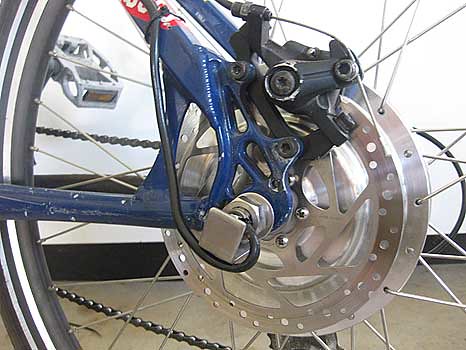

6) Mount battery rack. The 48V battery pack I got is larger than the 37V packs so instead of being able to hang it on the side of the wheel it has to be mounted on a dedicated rack that simply bolts to the seat post. Unfortunately this meant I had to remove the child seat rack for transporting my little guy around which is a shame.
This is a contributing factor to my second guessing the battery choice as the 37V might have fit inside the frame. I am looking at different mounting possibilities for the battery but the bottom line is it is bulky and sadly won't lend itself to many options; will be looking into trailer for the kids now.

7) Charge battery (wait for the green light!)
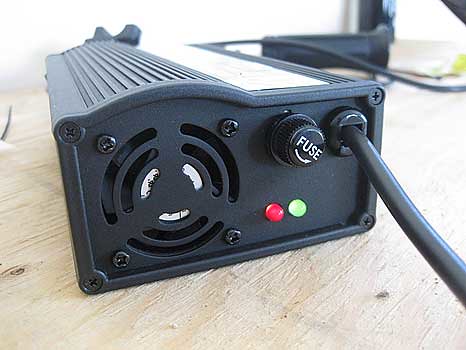
8) Mount the throttle and
the feedback panel (Cycle Analyst).
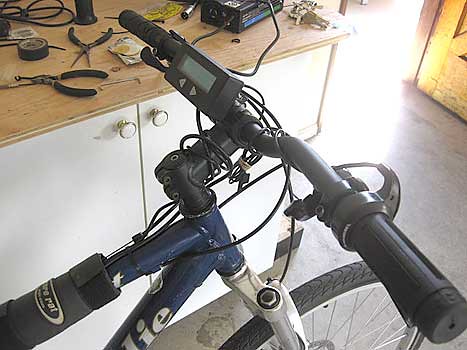
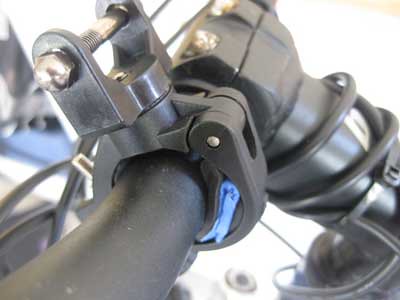
The diameter of the mounting bracket for the Cycle Analyst was way too big for my bars even with the included rubber padding doubled over so I put in a temp shim with masking tape.
I am also having some trouble finding the correct position of the throttle handle. The bandit has thumb trigger shifters which need to clear the end of the throttle housing when depressed and yet be close enough to not make shifting awkward. I am still experimenting but the set screw is a very small Allen key and it has now been rounded out making it difficult to adjust further. Make sure you use the exact wrench size when adjusting this screw.
9) Mount the controller.
Another observation: there is a general lack of mounting points on components like the battery case and controller. If there were mounting hard points on the cases it would make it easier to try different installation configurations. Since I am still looking at different options, for now I used a zip tie to strap the controller box up under the seat.

10) Slide the battery onto the rack and secure it

them onto the frame to avoid entanglements. The wiring setup is very simple especially with the diagram in the installation guide on the Grin site.
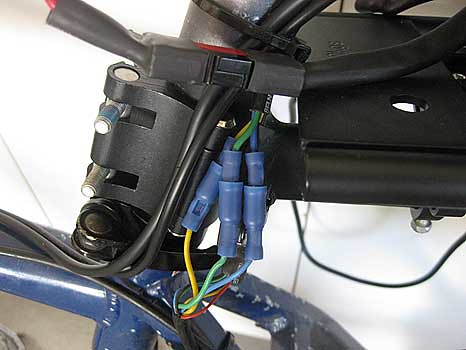
12) Turn on the key

13) Ride!
Before:
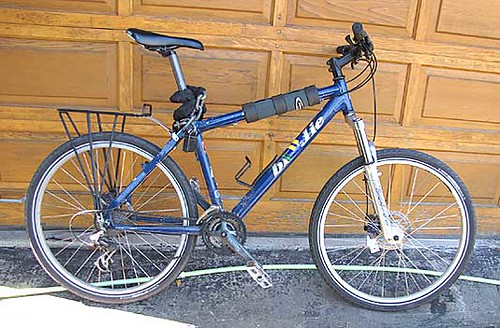
After:
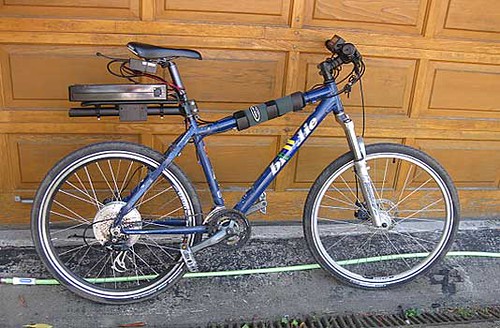
As I said this was a surprisingly
straightforward
project that didn't require any specialty tools or skills. Everything I needed was in the kit (thank you Margot @ ebikes).
Total build time over two days was a few hours (this would be significantly reduced for any subsequent builds).
Wrap up:
- be prepared to go through a lot of zip ties if you are going to play with different mounting configurations
- I weigh over 200 lbs and I have a very heavy chain lock so this is going to be a very rear-heavy bike. I am sure future changes will be driven by a desire to find a better balance
- aesthetics leave a lot to be desired
- I'm looking forward to finding the range of this battery/motor combination
- I need to find a trailer to transport the kids now
- still need to set up the speedometer
Feel free to drop me line if you have any comments or questions.
Saturday, July 10, 2010
Project Bandit: the kit
Traveled into Vancouver to pick up a conversion kit from Grin Technologies (ebike.ca).
Given this is my first attempt at a conversion I expect to find components I will want to change or upgrade as it is difficult to know what the impact of the trade-offs are going to be. I figure the best approach is to jump in with best guesses and upgrade as I learn more about the set-up. It's a lot like software development that way.
There are a number key of decisions to make when choosing a conversion kit.
Front or rear hub drive?
Basically what it sounds like. Do you want the source of power to be at the front of the bike (pull) or the rear(push); think front wheel drive vs. rear wheel drive in a car.
In terms of simplicity and weight distribution front hub is probably the way to go. The Bandit project is already going to already be rear heavy and a front hub motor would help but I am going with a rear hub. Maybe I'm just old-school but for the first kick at the can I'm trading the weight and simplicity of the front hub for the predictability of rear wheel.
note: I have seen discussions involving dual hub drives on the Endless Sphere forum but that can wait for a future project.
Direct drive or freewheel/gear drive?
Tough decision. Direct drive provides for regenerative braking but comes with some drag. Gear drives are more pedal friendly (freewheel), and lighter but don't allow for regen. From what I could find on the web there are roughly 3 'mainstream' hub motors to consider:
- eZee - gear drive
- Nine Continent - direct drive
- Crystalyte 400 Motors - direct drive
Since weight is already an issue on this project I am going with the eZee motor. I also like the idea of the freewheel.
Battery?
Choosing the battery was the most difficult for a number of reasons. The battery is the most expensive component and has the most effect on the quality of the ride (power/range) so the key is to optimize the price/range/power.
I am not an electronics whiz by any stretch so it was difficult to understand the trade-offs I was making between volts and amp hours. To put it simply:
- Volts are the power rating (acceleration, top speed, hill climbing, etc) - the higher the volt number the more power.
- Amp hours indicate the range of the battery (how big is your gas tank) - the lower the Ah number the shorter the range
For this project there were three choices:
- 37 V 9 Amp-hour Lithium-Manganese (this one comes with the kit)
- 48V 8Ah Samsung Pack
- 37V 14Ah Polymer
I figured I would want the extra power as I'm no featherweight so I went with the 48V Samsung. At 8Ah I do have some concerns about the range and won't be surprised if I begin to wonder if I should have sacrificed some torque for longer range (36V 14Ah).
Final kit:
- Standard eZee 26" rear drive kit
- Upgraded the battery to the 48V Samsung
- Added the Cycle Analyzer
Total cost (including the lousy new HST) $1700 (CDN).
Now for the build...
Wednesday, July 7, 2010
Project Bandit

Target: Brodie Bandit 'hard tail' circa 2003
History: Vancouver city commuter 2003 - 2009, retired to the suburbs (aka garage) March 2010
Specs: 18" frame, 26" rims, thumb shifters
Plan: Convert to electric assist DIY.
So the day has finally come to take the next step towards converting my bike to electric. I'm still researching options but am leaning towards one of the eZee kits from ebike.ca. I would like to keep the total project cost under $2000 and as this is meant to be a prototype/learning experience will try not to get to hung up on technology choices and keep battery/motor size choices as reasonable as possible.
I still have a number of questions/decisions around motor type / size, battery size and type.
I visited a couple of bike shops in the valley after doing some research online and they both carried and suggested Bionx systems they could order in for roughly $1700 - $2000. They indicated the actual conversion process would be pretty simple.
Being a DIY type I prefer the 'open' nature of the eZee bike system vs. the closed nature of the Bionix system. I just stumbled on the Endless Sphere forum which looks like a great research resource.
Time to find a conversion kit/motor for the project.
Lion Bikes
The name comes from a contraction of Lithium and Ion. I am optimistic the development of new Li-ion batteries and the next generation LiPo technology may mark a key milestone in the development of electric bikes (and other transportation). It seems ebikes are already taking China by storm so it seems the wave has already started.
I am personally very excited about the prospect of a more environmentally friendly, cost effective, reasonable range, and fun way to get around.
My brother in law built a DIY mountain bike conversion a couple of years ago using an array of DeWalt drill batteries and I couldn't believe how much fun it was to ride.
So finally I am jumping into my own conversion project. Sadly, I missed the first ebike show and competition this year by a week but hope to be there next year. It looked like an interesting group of people.
Subscribe to:
Posts (Atom)
